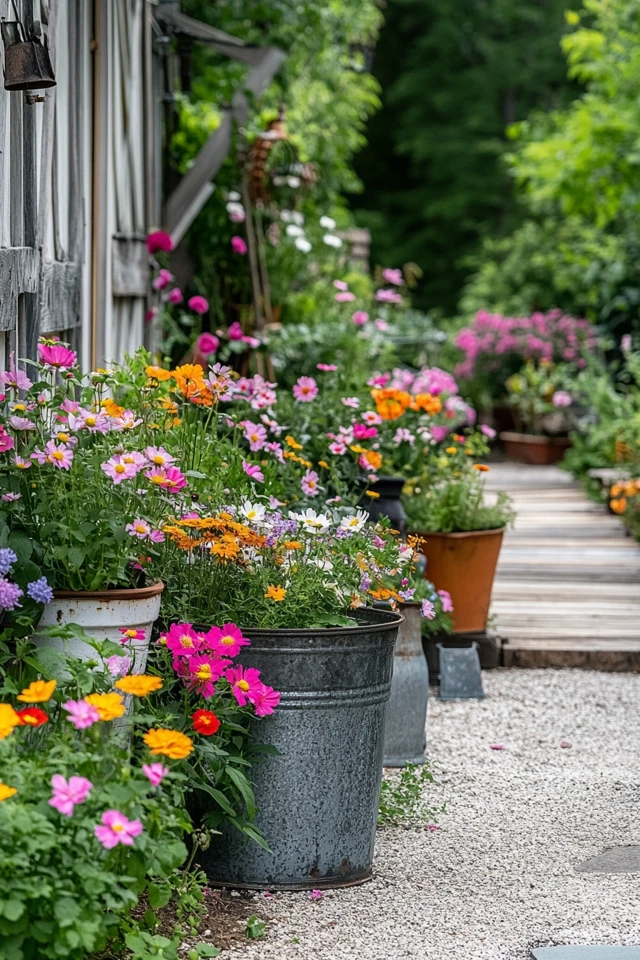Introduction
There’s something truly magical about a farmhouse garden—it’s a place where rustic charm meets nature’s beauty. Decorating your garden with salvaged materials takes this magic to the next level by adding character, sustainability, and a personal touch. Whether it’s repurposing old doors as trellises or turning vintage buckets into planters, using salvaged materials allows you to create a garden that tells a story and feels uniquely yours.
I first discovered the joy of decorating with salvaged materials when I stumbled upon an old ladder at a flea market. With a little creativity, I transformed it into a tiered plant stand for my herb garden. That one piece sparked a passion for finding new uses for old items, and now my garden is filled with treasures like a vintage wheelbarrow turned flower bed and a reclaimed wood fence adorned with lanterns. These pieces not only make my garden beautiful but also remind me of their past lives and the joy of giving them new purpose.
If you’re ready to transform your garden into a farmhouse-inspired retreat, this guide will show you how to use salvaged materials to create a space that’s both charming and eco-friendly.
The Perfect Design for You
Decorating a farmhouse garden with salvaged materials is perfect for anyone who loves the idea of blending rustic charm with sustainability. Whether you have a sprawling backyard or a small patio, incorporating repurposed items can add character and functionality to your outdoor space.
Picture a garden filled with vintage planters, rustic wooden benches, and whimsical touches like an old wagon wheel leaning against a flower bed. With salvaged materials, you can create a farmhouse garden that’s as unique as it is beautiful, all while reducing waste and embracing a creative approach to decor.
Picture Gallery
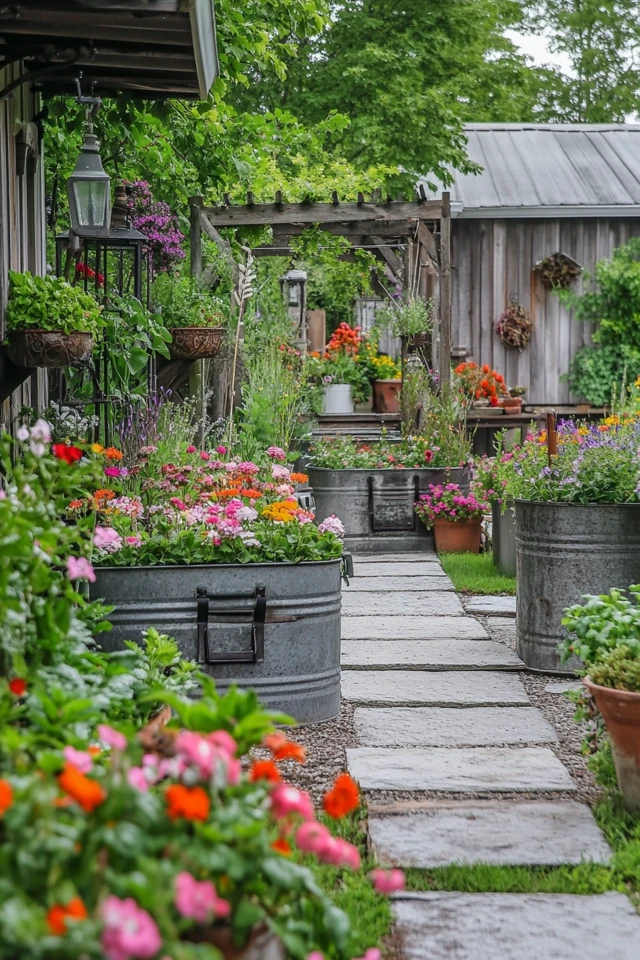
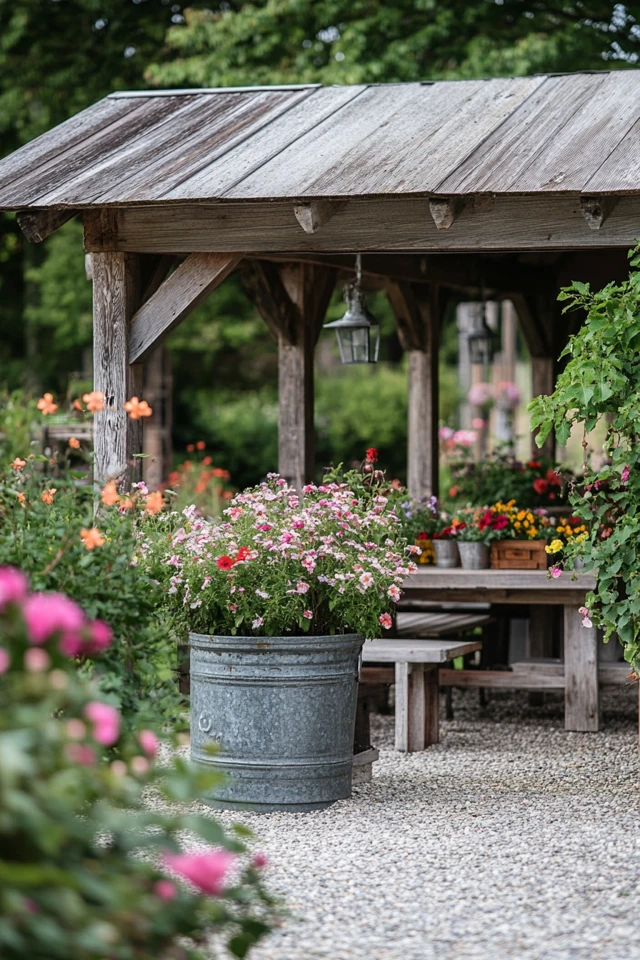
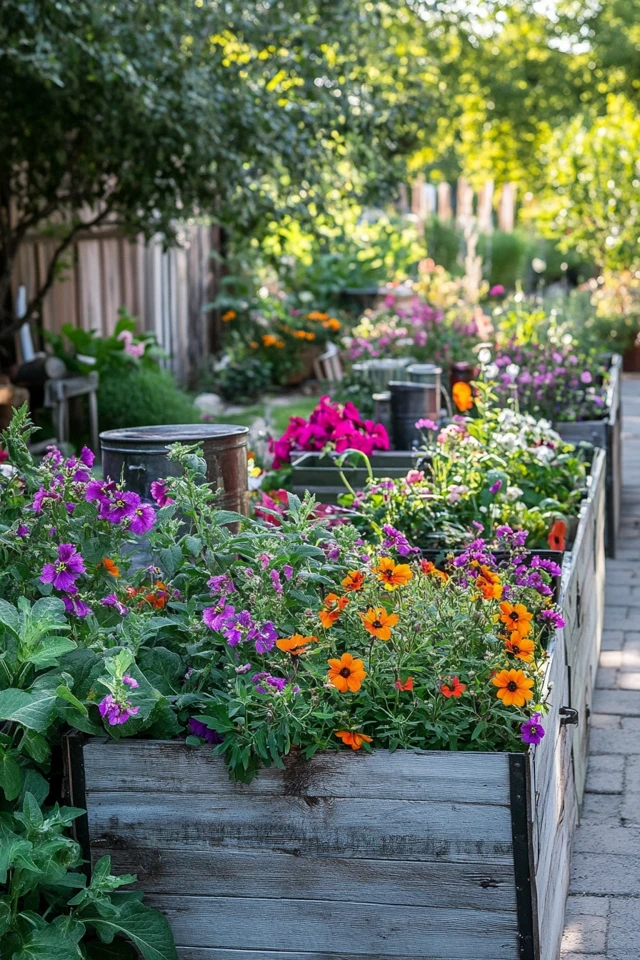
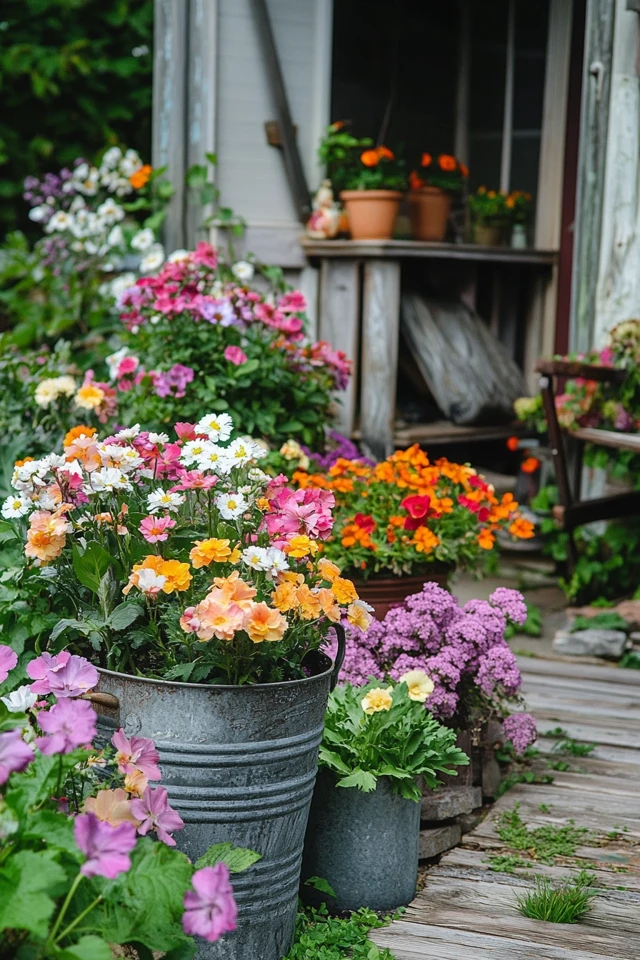
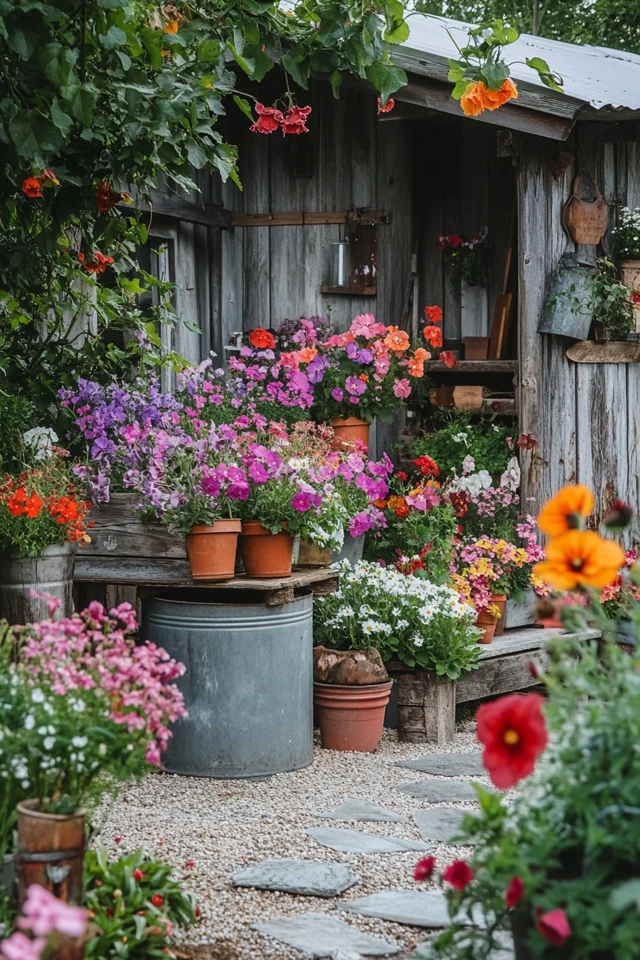
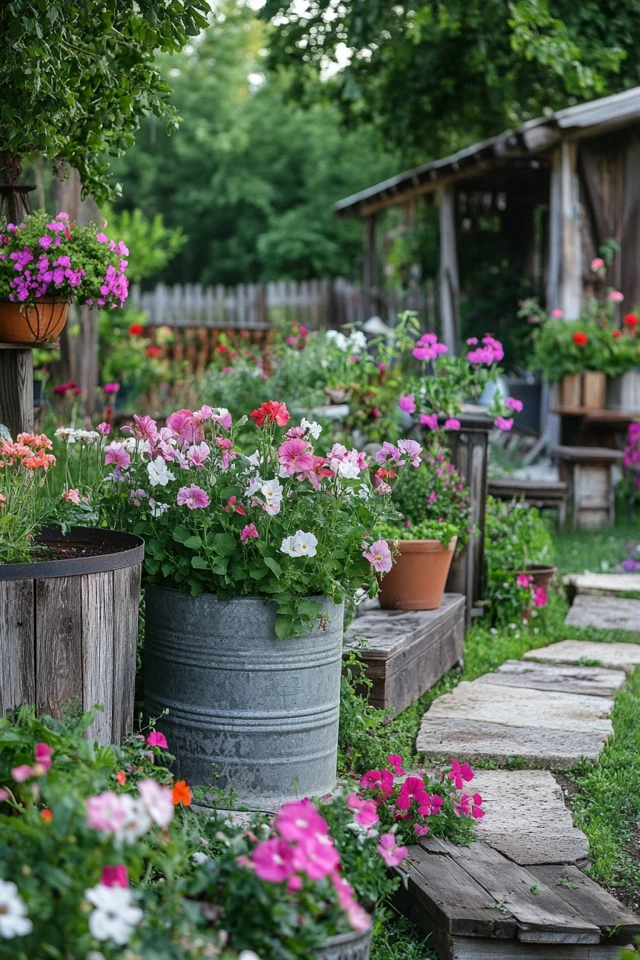
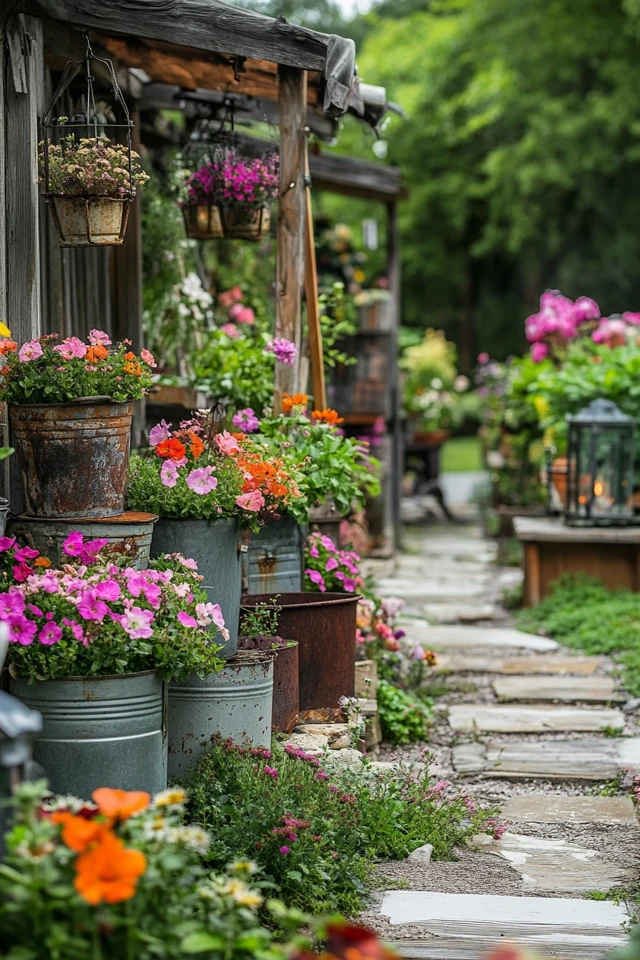
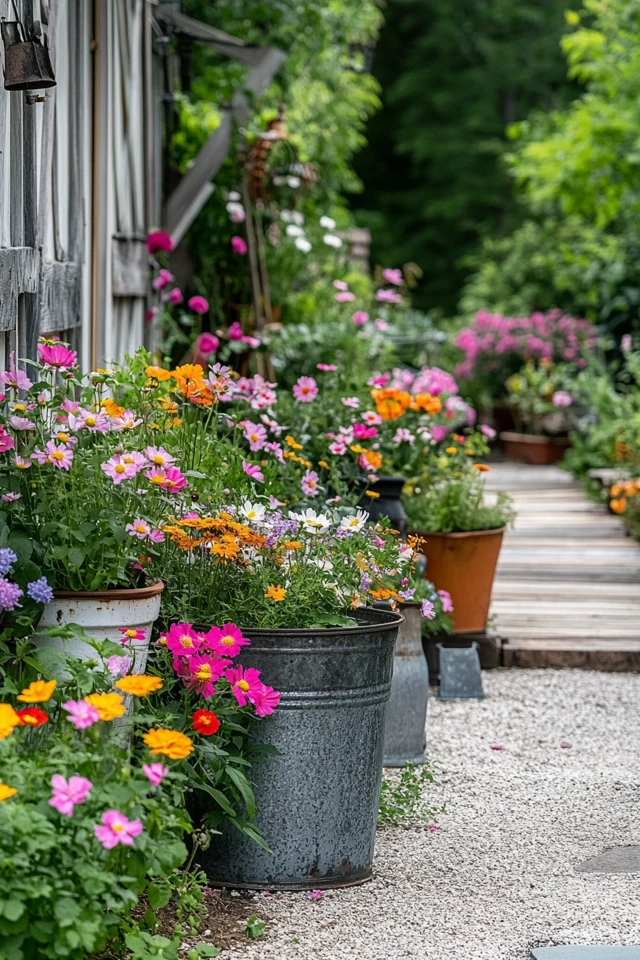
Why These Key Elements Work So Well Together
Salvaged materials and farmhouse gardens are a match made in heaven because they share core design principles: rustic charm, natural textures, and timeless appeal. Here’s why these elements work so beautifully together:
- Repurposed Materials: Old wood, metal, and stone add texture and history to your garden.
- Natural Colors: Weathered finishes and earthy tones blend seamlessly with plants and greenery.
- Functional Decor: Salvaged items like ladders, crates, and barrels can double as storage or plant stands.
- Personal Touch: Each piece tells a story, making your garden feel uniquely yours.
- Sustainability: Repurposing materials reduces waste and gives new life to forgotten treasures.
How to Decorate a Farmhouse Garden With Salvaged Materials
1. Turn Old Doors Into Trellises
- Design: Repurpose vintage doors as trellises for climbing plants like roses or ivy.
- Why It Works: The height and texture of the doors add a vertical focal point to your garden.
- Styling Tips: Leave the paint chipped for a rustic look, or repaint them in soft white or sage green for a fresh farmhouse vibe.
2. Use Vintage Buckets as Planters
- Design: Fill old metal buckets with flowers, herbs, or succulents for a charming touch.
- Why It Works: The weathered metal adds rustic texture, while the buckets’ portability makes them versatile.
- Styling Tips: Drill holes in the bottom for drainage and group them in clusters for visual impact.
3. Create a Fence With Reclaimed Wood
- Design: Build a fence or garden border using salvaged wood planks or pallets.
- Why It Works: The distressed wood creates a natural, farmhouse-inspired boundary for your garden.
- Styling Tips: Add decorative touches like hanging lanterns, vintage signs, or small flower pots.
4. Transform an Old Ladder Into a Plant Stand
- Design: Use a wooden ladder to display potted plants, herbs, or flowers in tiers.
- Why It Works: The ladder’s vertical design makes it a space-saving and eye-catching feature.
- Styling Tips: Paint the ladder in a soft pastel or leave it natural for a weathered look.
5. Repurpose a Wheelbarrow as a Flower Bed
- Design: Fill an old metal or wooden wheelbarrow with soil and plant colorful flowers or greenery.
- Why It Works: The wheelbarrow adds a whimsical, rustic touch while doubling as a movable planter.
- Styling Tips: Choose vibrant blooms for contrast or stick to a monochromatic palette for elegance.
6. Use Mason Jars as Hanging Lights
- Design: Turn mason jars into lanterns by adding candles or string lights and hanging them from tree branches or hooks.
- Why It Works: The soft glow creates a magical atmosphere, perfect for evening garden parties.
- Styling Tips: Wrap the jars with twine or wire for easy hanging and extra farmhouse flair.
7. Incorporate Antique Tools as Decor
- Design: Display vintage gardening tools like rakes, hoes, or spades on a garden wall or fence.
- Why It Works: These items add a sense of history and tie the decor to the garden’s purpose.
- Styling Tips: Arrange the tools in a pattern or hang them alongside flower pots for a cohesive look.
8. Build Raised Beds With Salvaged Materials
- Design: Use old bricks, wood planks, or metal sheets to create raised garden beds.
- Why It Works: Raised beds add structure to your garden while repurposing materials in a functional way.
- Styling Tips: Line the beds with natural stones or gravel to enhance the rustic aesthetic.
9. Repurpose Windows Into Greenhouse Panels
- Design: Use vintage window frames to build a small greenhouse or cold frame for your plants.
- Why It Works: The glass and wood combination adds farmhouse charm while protecting your plants.
- Styling Tips: Arrange the windows into a simple A-frame or lean them against an existing structure.
10. Use Old Crates for Storage and Decor
- Design: Stack wooden crates to create shelves, or use them as planters and storage boxes.
- Why It Works: Crates are versatile and add a rustic, utilitarian touch to your garden.
- Styling Tips: Stencil labels onto the crates for a vintage-inspired look.
How to Style Your Salvaged Materials
- Mix and Match: Combine wood, metal, and stone elements for a layered, dynamic look.
- Stick to a Palette: Use earthy tones and natural finishes to maintain a cohesive farmhouse aesthetic.
- Add Greenery: Pair salvaged materials with vibrant plants or flowers for contrast and balance.
- Keep It Functional: Use salvaged items as both decor and practical garden tools or features.
- Personalize It: Incorporate family heirlooms or items with sentimental value to make your garden truly unique.
FAQ Section
1. Where can I find salvaged materials for my garden?
- Check thrift stores, flea markets, salvage yards, or even your own attic or garage for hidden treasures.
2. Can I use salvaged materials in a small garden?
- Absolutely! Focus on smaller items like crates, mason jars, or ladders to avoid overcrowding.
3. How do I protect salvaged materials from the elements?
- Seal wood with outdoor-safe varnish, use rust-resistant paint on metal, and clean items regularly to maintain their charm.
4. Can I incorporate salvaged materials in a modern garden?
- Yes! Pair salvaged items with sleek, contemporary elements for a modern-rustic fusion.
5. How do I ensure my garden doesn’t look cluttered with too many salvaged pieces?
- Choose a few key items to highlight and space them thoughtfully to maintain balance and cohesion.
Variations
- Rustic Farmhouse Garden: Focus on weathered wood, antique tools, and galvanized metal accents for a classic look.
- Modern Farmhouse Garden: Use clean-lined salvaged materials like painted doors or minimalist ladder shelves for a contemporary touch.
- Coastal Farmhouse Garden: Incorporate driftwood, nautical ropes, and light blue accents for a breezy vibe.
- Boho Farmhouse Garden: Add colorful fabrics, eclectic planters, and macramé accents for a whimsical, relaxed feel.
- Industrial Farmhouse Garden: Use metal piping, corrugated steel, and dark wood for an edgy, industrial aesthetic.
How to Showcase It
- Before-and-After Photos: Highlight the transformation of your garden with salvaged materials.
- Seasonal Decor: Show how you’ve updated your garden with seasonal accents like pumpkins or holiday lights.
- Unique Features: Share close-ups of your most creative salvaged pieces and their new uses.
Occasions to Feature It
- Garden Parties: Use your farmhouse garden as a charming backdrop for outdoor gatherings.
- Seasonal Celebrations: Decorate with salvaged items to celebrate holidays like Easter or Halloween.
- Everyday Enjoyment: Create a serene space for daily relaxation and connection with nature.
Conclusion
Decorating a farmhouse garden with salvaged materials is a creative and rewarding way to add personality and charm to your outdoor space. From old doors and ladders to vintage tools and buckets, repurposing these items not only enhances your garden’s aesthetic but also tells a story of sustainability and ingenuity.
Start exploring local thrift shops, flea markets, or even your own garage to find hidden treasures waiting for a second life. With a little creativity and effort, you can transform your garden into a rustic retreat that feels timeless, inviting, and uniquely yours.

